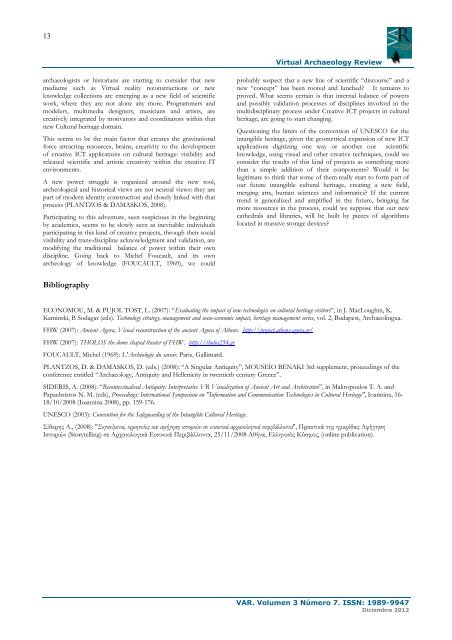Virtual Museums
Virtual Museums
Virtual Museums
Create successful ePaper yourself
Turn your PDF publications into a flip-book with our unique Google optimized e-Paper software.
13<br />
archaeologists or historians are starting to consider that new<br />
mediums such as <strong>Virtual</strong> reality reconstructions or new<br />
knowledge collections are emerging as a new field of scientific<br />
work, where they are not alone any more. Programmers and<br />
modelers, multimedia designers, musicians and artists, are<br />
creatively integrated by motivators and coordinators within that<br />
new Cultural heritage domain.<br />
This seems to be the main factor that creates the gravitational<br />
force attracting resources, brains, creativity to the development<br />
of creative ICT applications on cultural heritage: visibility and<br />
released scientific and artistic creativity within the creative IT<br />
environments.<br />
A new power struggle is organized around the new tool,<br />
archeological and historical views are not neutral views: they are<br />
part of modern identity construction and closely linked with that<br />
process (PLANTZOS & DAMASKOS, 2008).<br />
Participating to this adventure, seen suspicious in the beginning<br />
by academics, seems to be slowly seen as inevitable: individuals<br />
participating in this kind of creative projects, through their social<br />
visibility and trans-discipline acknowledgment and validation, are<br />
modifying the traditional balance of power within their own<br />
discipline. Going back to Michel Foucault, and its own<br />
archeology of knowledge (FOUCAULT, 1969), we could<br />
Bibliography<br />
<strong>Virtual</strong> Archaeology Review<br />
probably suspect that a new line of scientific “discourse” and a<br />
new “concept” has been rooted and lunched? It remains to<br />
proved. What seems certain is that internal balance of powers<br />
and possibly validation processes of disciplines involved in the<br />
multidisciplinary process under Creative ICT projects in cultural<br />
heritage, are going to start changing.<br />
Questioning the limits of the convention of UNESCO for the<br />
intangible heritage, given the geometrical expansion of new ICT<br />
applications digitizing one way or another our scientific<br />
knowledge, using visual and other creative techniques, could we<br />
consider the results of this kind of projects as something more<br />
than a simple addition of their components? Would it be<br />
legitimate to think that some of them really start to form part of<br />
our future intangible cultural heritage, creating a new field,<br />
merging arts, human sciences and informatics? If the current<br />
trend is generalized and amplified in the future, bringing far<br />
more resources in the process, could we suppose that our new<br />
cathedrals and libraries, will be built by pieces of algorithms<br />
located in massive storage devices?<br />
ECONOMOU, M. & PUJOL TOST, L. (2007): “Evaluating the impact of new technologies on cultural heritage visitors”, in J. MacLoughin, K.<br />
Kaminski, B Sodagar (eds). Technology strategy, management and socio-economic impact, heritage management series, vol. 2, Budapest, Archaeolingua.<br />
FHW (2007): Ancient Agora, Visual reconstruction of the ancient Agora of Athens. http://project.athens-agora.gr/<br />
FHW (2007): THOLOS the dome shaped theater of FHW. http://tholos254.gr<br />
FOUCAULT, Michel (1969): L'Archéologie du savoir. Paris, Gallimard.<br />
PLANTZOS, D. & DAMASKOS, D. (eds.) (2008): “A Singular Antiquity”, MOUSEIO BENAKI 3rd supplement, proceedings of the<br />
conference entitled “Archaeology, Antiquity and Hellenicity in twentieth century Greece”.<br />
SIDERIS, A. (2008): “Recontextualised Antiquity: Interpretative VR Visualization of Ancient Art and Architecture”, in Makropoulos T. A. and<br />
Papachristos N. M. (eds), Proceedings: International Symposium on "Information and Communication Technologies in Cultural Heritage", Ioannina, 16-<br />
18/10/2008 (Ioannina 2008), pp. 159-176.<br />
UNESCO (2003): Convention for the Safeguarding of the Intangible Cultural Heritage.<br />
Σίδερης Α., (2008): "Συγκείµενα, ερµηνείες και αφήγηση ιστοριών σε εικονικά αρχαιολογικά ̟εριβάλλοντα", Πρακτικά της ηµερίδας Αφήγηση<br />
Ιστοριών (Storytelling) σε Αρχαιολογικά Εικονικά Περιβάλλοντα, 25/11/2008 Αθήνα, Ελληνικός Κόσµος, (online publication).<br />
VAR. Volumen 3 Número 7. ISSN: 1989-9947<br />
Diciembre 2012


